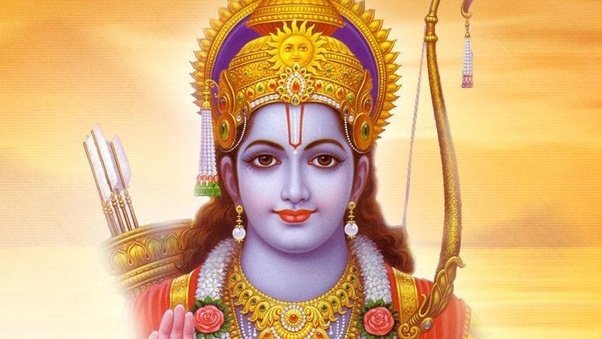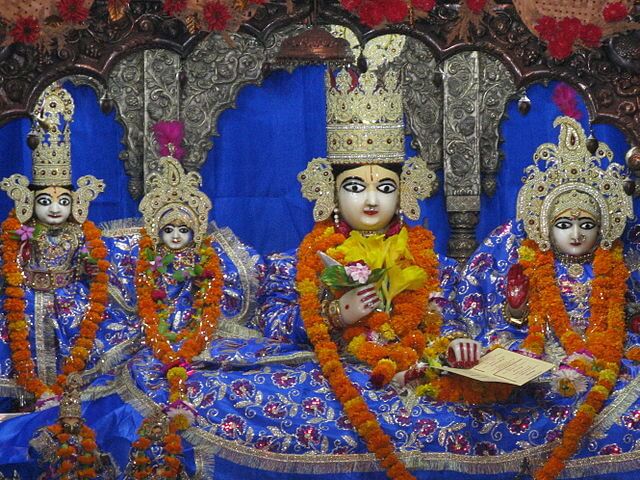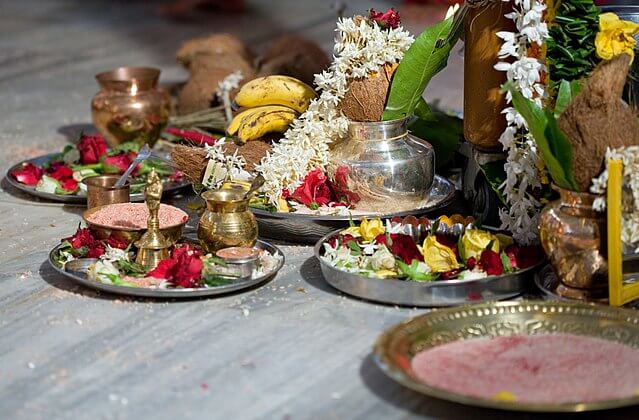Ram Navami is a revered Hindu festival that commemorates the birth of Lord Rama, one of the most beloved deities in Hinduism. It falls on the ninth day of the Hindu lunar calendar month of Chaitra and is celebrated with immense joy and devotion. Ram Navami holds deep spiritual significance for millions of Hindus worldwide, since it signifies the victory of Dharma (good and harmony) over Adharma (evil and disharmony).
Ram Navami celebrations include devotional singing, religious gatherings, chariot parades and distribution of prasad (food offerings). Devotees recite the Hindu epic Ramayana, and actors perform re-enactments of Rama’s life in open air stages.
The festival of Ram Navami serves as an inspiration for devotees, reminding them of the values of truth, devotion, and moral conduct. Through prayers, devotional singing, and recitation of sacred scriptures, followers seek blessings, inner peace, and spiritual growth. Ram Navami is not only a celebration of Lord Rama’s divine birth but also a time for reflection, devotion, and embracing the ideals that he represents.
Featured Image: Photo by Sonika Agarwal on Unsplash
You may also like:
Rama Navami Symbolism: The Triumph of Good Over Evil
Lord Rama: One of the Most Beloved Hindu Gods
Ramayana: One of the Most Beautiful Ancient Indian Epics
Table of Contents
- The Story of Lord Rama
- Ram Navami Celebrations
- Ratha Yatra
- Ramlila
- The Ram Navami Vrata
- Performing the Worship Ritual of Puja (Pooja)
- Singing the Bhajans
- Fasting
- How to Keep Fast on Ram Navami
- What to Eat on Ram Navami
- Celebrate Ram Navami with Shastra & Aarti
- Give Prasad to the Poor & the Devotees
- Invite Relatives for Dinner
The Story of Lord Rama

Lord Rama or Ram, the seventh incarnation of Lord Vishnu, is the ideal king and warrior in Hinduism. According to Hindu mythology, Lord Rama was born to King Dasharatha and Queen Kaushalya of Ayodhya.
The king had three queens: Kaikeya, Sumitra, and Kushalya, but none could bear him an heir. In order to be blessed with children, the sage Vasashtha suggested performing a sacred rite called Putrakameshthi Yagna. After performing the yagna, the king was blessed with four sons, Rama being the eldest.
Known for his bravery, great power and compassion, Lord Rama is the epitome of truth, morality, and righteousness. He embodies the highest ideals of man. His story is documented in the ancient Hindu epic Ramayana, which narrates his life, battles, and ultimate triumph over evil.
Lord Rama is also called Ramachandra (meaning beautiful moon), or Raghava (descendant of the Raghu solar dynasty). In fact, there are 108 divine names, known as Rama Ashtottara Shatanamavali, to express the splendor and greatness of Lord Rama.
Ram Navami Celebrations

Ram Navami is a time for spiritual reflection and devotion, as well as social and community gatherings.The festival is observed by fasting, prayers, and devotional songs, and culminates in grand processions and cultural programs. It is particularly significant in the Hindu-majority Indian states of Uttar Pradesh, Bihar, and Madhya Pradesh.
Ratha Yatra
Ratha yatras are chariot parades with idols of Lord Ram and his wife Sita, his brother Lakshmana, and Hanuman. These idols are taken out from many Hindu temples on a procession, followed by devotees chanting Rama Nama. Attending the chariot parade is believed to bring spiritual enlightenment and good luck.
Ramlila
During Ram Navami, Ramlilas are performed by actors in an open air stage. Meaning “Rama’s Play”, the Ramlila is a re-enactment of Rama’s life according to the epic Ramayana.
The Ram Navami Vrata
Vrata is a sanskrit term meaning vow, observance, duty and refers to the rituals followed for the day. According to Hindu mythology, Lord Rama is a descendant of the Hindu god Suraj Devta (The Sun). This is why the day of Ram Navami starts with a sacred ritual offering of Ganga Jal (water from the holy river Ganga) or plain water to the Hindu Sun god at sunrise.
Performing the Worship Ritual of Puja (Pooja)

Before performing the worship ritual of Puja, it is important for the house to be clean and bright. Pictures or idols of Lord Ram, Lakhsman, Sita and Hanuman are placed on a dais along with flowers and incense in preparation for the ritual.
Two thalis (large metal trays hosting smaller bowls) are placed in the area of worship: one containing the prasad (offerings of fruit and sweets) and the other the items necessary for the ritual like Ganga jal (water from the river Ganges), roli (vermillion), aipun, rice, flowers, a bell and a conch.
The youngest female of the household leads the ritual. She starts by applying tilak to all the males and a red bindi on the foreheads of all the females. The puja starts by sprinkling the water, roli, and aipun on the deities and then showering them with handfuls of rice. Following, everybody stands up for the aarti, and then Ganga jal or plain water is sprinkled over the gathering. The singing of bhajans continues throughout the ritual and in the end the prasad is shared among all the people gathered.
The Sri Ram Chalisa, which is chanted at the end of the puja, is a 40 verse prayer to Lord Ram and bestows divine blessings upon the devotees.
Singing the Bhajans
Bhajans, which are sung both in Temples and at homes, are devotional songs and a vital part of Ram Navami pooja. Devotees sing the bhajans and quatrain verses from the epic poem Ramayana, which recounts Lord Rama’s life story and adventures.
The continuous reciting of Sri Ram mantras and Rama Naama (Rama’s holy name) creates an otherworldly mystical and spiritual atmosphere. The “Sri Rama Shloka”, is a very popular chant also, and is revered as one of the most powerful ones, with tremendous benefits for the devotees. It is a couplet in which each line contains 16 syllables:
श्री राम राम रामेति रमे रामे मनोरमे ।
सहस्रनाम तत्तुल्यं रामनाम वरानने ॥
English Transliteration:
Shri Rama Rama Rameti Rame Rame Manorame
Sahasrenama tattulyam Rama Nama Varanane
Meaning:
By chanting the name of Rama, I get great pleasure. The Name of Rama is equal to the thousand names of Vishnu.
Fasting
Devotees of Lord Rama keep a whole-day fast during the festival of Ram Navami and many also observe a waterless fast until midnight.
How to Keep Fast on Ram Navami
Devotees keep fast during Rama Navami to receive blessing and great prosperity from Lord Ram. There are 3 types of fasting :
- until noon
- until midnight (eating only once during the day)
- fasting for 9 days from the start of Chaitra until Ram Navami day.
What to Eat on Ram Navami
When having a single meal during the fast, it may consist of fruits and fruit extracts. Alternatively, when eating a full meal, it can include potatoes but without garlic, ginger, onion or turmeric.
Meat, eggs, as well as certain wheat products and spices are not permitted. You may eat Sabudana khichdi or use kuttu/singhara flour to make puris, halwa, and chapati. You may also eat vegetables, curd, tea, coffee, milk and yogurt, although many refrain from dairy products altogether.
Celebrate Ram Navami with Shastra & Aarti

For many, the most important part of Ram Navami is to read shastras and participate in aarti. The shastras are recitations of various hymns and myths that narrate the legends of Lord Ram. Aarti is the ritualistic offering of flowers, fruits, light or incense to gods.
Give Prasad to the Poor & the Devotees
The poor and those suffering from disease are considered to Lord Rama’s favorite souls. You can feed the poor and needy who come to your place and offer them food items as prasad. Alternatively, you can take prasad to poor people’s homes and you can also offer food items to the devotees of Lord Ram in temples.
Invite Relatives for Dinner
Ram Navami is a joyous and festive occasion so what better way to celebrate it than to invite close relatives, friends, or neighbors for dinner. You can treat your guests to roti, rice, paratha, dal, kheer, pickles, curd, fruits and sweets such as laddu and jalebi.
Happy Ram Navami
शुभ रामनवमी
Shubh Ram Navami
- Ardhanarishvara: The Powerful Synthesis of the Two Opposites in One

- Hanuman: The Most Valuable Life Lessons from the Monkey God

- King Kakudmi: One of the Most Amazing Hindu Myths

- Dharmapala: The Powerful Guardians of the Buddhist Path

- Bardo Thodol: Unveiling the Hidden Secrets of Life & Death

- Kakbhushundi: One of the Most Fascinating Tales from Hindu Mythology






